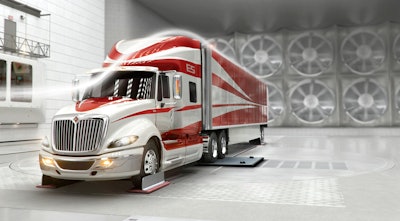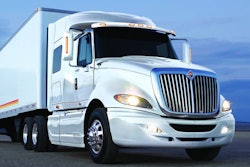 The International ProStar ES
The International ProStar ESNavistar’s going “lean and mean,” the company announced today to an audience of Wall Street analysts and trucking industry press, pointing to hundreds of millions of dollars in savings on manufacturing, materials and structured costs as the latest step in its turnaround efforts.
Navistar hosted an analyst day at its Lisle, Ill., headquarters Feb. 4 to update investors and the media on the progress of the company’s ongoing efforts to get back in the black following its failed attempt at meeting emissions standards using exhaust gas recirculation rather than aftertreatment methods adopted by other truck makers.
Bill Kozek who took over Navistar’s helm in 2013 after leaving Paccar.
Both Kozek and CEO Troy Clarke praised Navistar’s dedicated and determined employees who have spearheaded the effort and report several positive developments.
Kozek noted that the massive push to convert the entire International product line from exclusive, proprietary, MaxxForce engines with EGR to full integration with Cummins 15 liter diesel engines and Cummins Selective Catalytic Reduction (SCR) technology is in the final stages of implementation.
Clarke said the effort was completed in record time, while the company continued new product development and worked to re-engineer 2010 emissions systems to provide better uptime and resale values for EGR-era International trucks.
The company expects the final vocational models to be fully SCR-converted by June of this year.
Additional positive restructuring accomplishments highlighted the company’s transition to a trimmed-up business model, including $120 million in lower manufacturing costs, $640 million in structured cost savings, “significant” material cost reductions, a 50 percent improvement in working capital, “flawless” new product launches like the new, aerodynamic-optimized ProStar ES and measurable product quality improvements.
Other restructuring efforts include the divestment of non-core businesses and joint ventures and closing or idling several production facilities, like the company’s Huntsville, Ala., engine plant and Indianapolis foundry operation. All told, the company reported more than 2,000 cost saving initiatives today with an overall realized goal of a 5 percent reduction in material costs.
With that major product restructuring almost complete, Kozek said Navistar is now shifting its focus to recapturing market share in both on-highway and vocational markets.
With those new goals in mind, Navistar today launched a new “It’s Uptime at International” marketing campaign to highlight its efforts of minimizing truck downtime.
Key enablers in this push will include investments and training to create a “high performance” dealer network as well as leveraging and expanding the company’s OnCommand Connection telematics system to streamline the repair process for fleets.
Kozek says he expects to see these efforts translate into increased truck sales in 2015 with Navistar increasing its volume in the Class 8 market by 1,000 to 2,000 units this year. The company also expects to grow vocational Class 6 and 7 sales by an aggressive 4,000 – 5,000 units as that segment heats up later in the year.
Modest growth this year with ongoing new product development
Navistar remains hampered by a lingering hangover from its EGR emissions strategy, including a hard financial hit by warranty claims and and a used truck inventory and trade cycle that Kozek estimated to be about two years away from normalizing.
At the same time, the company’s market share recovery efforts have been slower than predicted. On a positive note, Navistar says it has now moved past the peak period of 2010 warranty claims and expects to see them become less of a drag on the company’s finances in the near future. As a result of this mixed bag, Kozek says he expects to see “modest’ growth in 2015.
Denny Mooney, Navistar’s vice president of global product development, says that the company’s engine philosophy has evolved from its “go it alone” approach of a few years ago to fostering relationships around the globe — with an eye toward delivering leading technology and product regardless of where it originates.
“Our competitors are talking about ‘vertical integration’ that leaves fleets fewer choices in technology and components,” Mooney said. “Our approach is different. We will offer leading technology and components from global suppliers and get to market quickly and allow our customers to compete with the products that work best for their application.”
An upshot of this strategy, Mooney adds, is reduced lead time and development costs, which help Navistar be more responsive to customer needs while keeping product development costs low. “That’s real efficiency,” he noted.
Mooney also highlighted ongoing new truck projects. These trucks are in the development pipeline now with launches scheduled for late 2016 and 2017. These new models are direct offshoots from the company’s “Project Horizon” conceptual truck project and will feature enhanced aerodynamics and fuel economy, as well as modern, “flexible” interiors that offer drivers the highest level of connectivity and conveniences.
The meeting wrapped up with remarks by Navistar chief financial officer Walter Borst, who noted that the company’s financial house is close to coming to order now, with material cost reductions helping offset the SCR-integration efforts.
Borst also noted that Navistar’s four key operational costs (material costs, structural costs, manufacturing and warranty costs) were all substantially lower in 2014. As a result, Borst says many of these savings will fall directly to the company’s bottom line in 2015 since the costs of SCR implementation are largely in the past now.
Combined with Kozek’s anticipated 15 percent uptick in unit sales this year, Borst says these this aggressive savings program will allow Navistar to hit its target financial numbers by year’s end and to solidify a position as a market leader by 2017.











